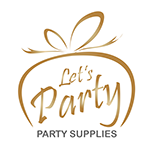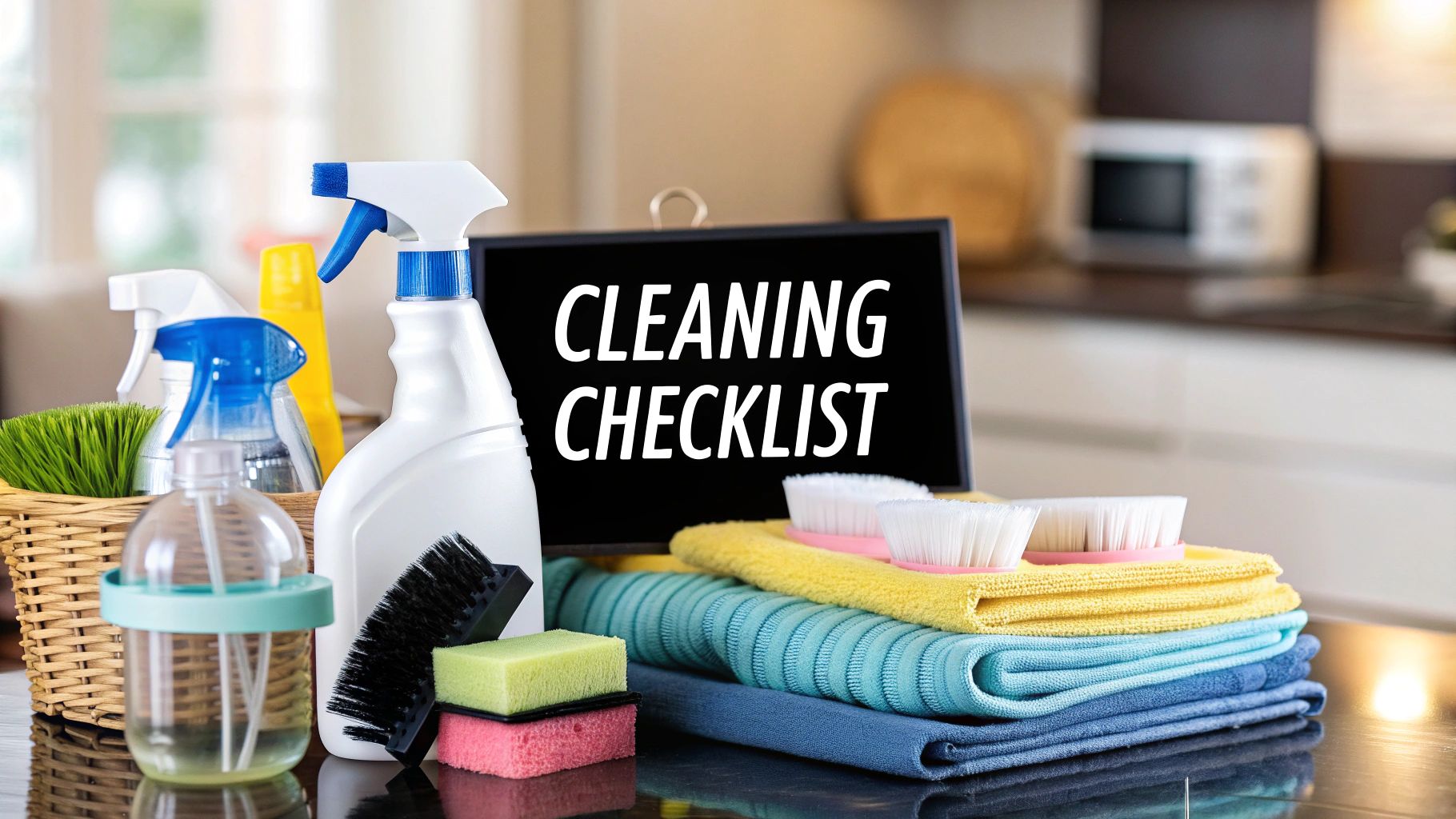
A solid household cleaning supplies checklist is more than just a random collection of sprays and sponges. It’s your toolkit for a clean, comfortable home, and having the right items ready to go makes every cleaning session—from a quick wipe-down to a deep scrub—so much easier.
Your Essential Household Cleaning Supplies Checklist
Before you get bogged down in specialized cleaners for every nook and cranny, let's build a foundational kit. Think of these as the absolute must-haves that will tackle the vast majority of your daily and weekly cleaning tasks. Some people even refer to these as their non-negotiable cleaning supplies, and for good reason. Without them, you're just not fully equipped.
Having a well-organized checklist and supply stash is a game-changer. It prevents those frustrating, mid-cleaning dashes to the store and ultimately saves you time and money. The key is to keep everything accessible and topped up.
Starting Your Supply Inventory
I'm a big believer in the cleaning caddy. Seriously, get one. It lets you carry your core tools from room to room, which turns a choppy, start-and-stop chore into a smooth, efficient process. To get you started on what to put in that caddy, here's a quick reference table covering the absolute basics.
For a quick glance at what you should always have on hand, this table breaks down the essentials.
Core Cleaning Supplies Quick Reference Guide
| Supply Item | Primary Use | Recommended Stock Check Frequency |
|---|---|---|
| All-Purpose Cleaner | Wiping down counters, spot-cleaning spills | Monthly |
| Microfiber Cloths | Dusting, polishing, wiping surfaces | Check for wear every 2-3 months |
| Scrub Sponges | Washing dishes, scrubbing tough grime | Replace every 2-4 weeks |
| Rubber Gloves | Protecting hands from chemicals and hot water | Check for holes before each use |
| Glass Cleaner | Cleaning windows, mirrors, and glass surfaces | Every 2-3 months |
| Disinfecting Wipes | Quickly sanitizing high-touch areas | Monthly |
| White Vinegar | Natural cleaning, descaling, and deodorizing | Every 3-4 months |
| Baking Soda | Gentle abrasive for scrubbing and deodorizing | Every 3-4 months |
This approach ensures you're never caught off guard when a mess happens. Keeping these items stocked is the first step to a consistently clean home.
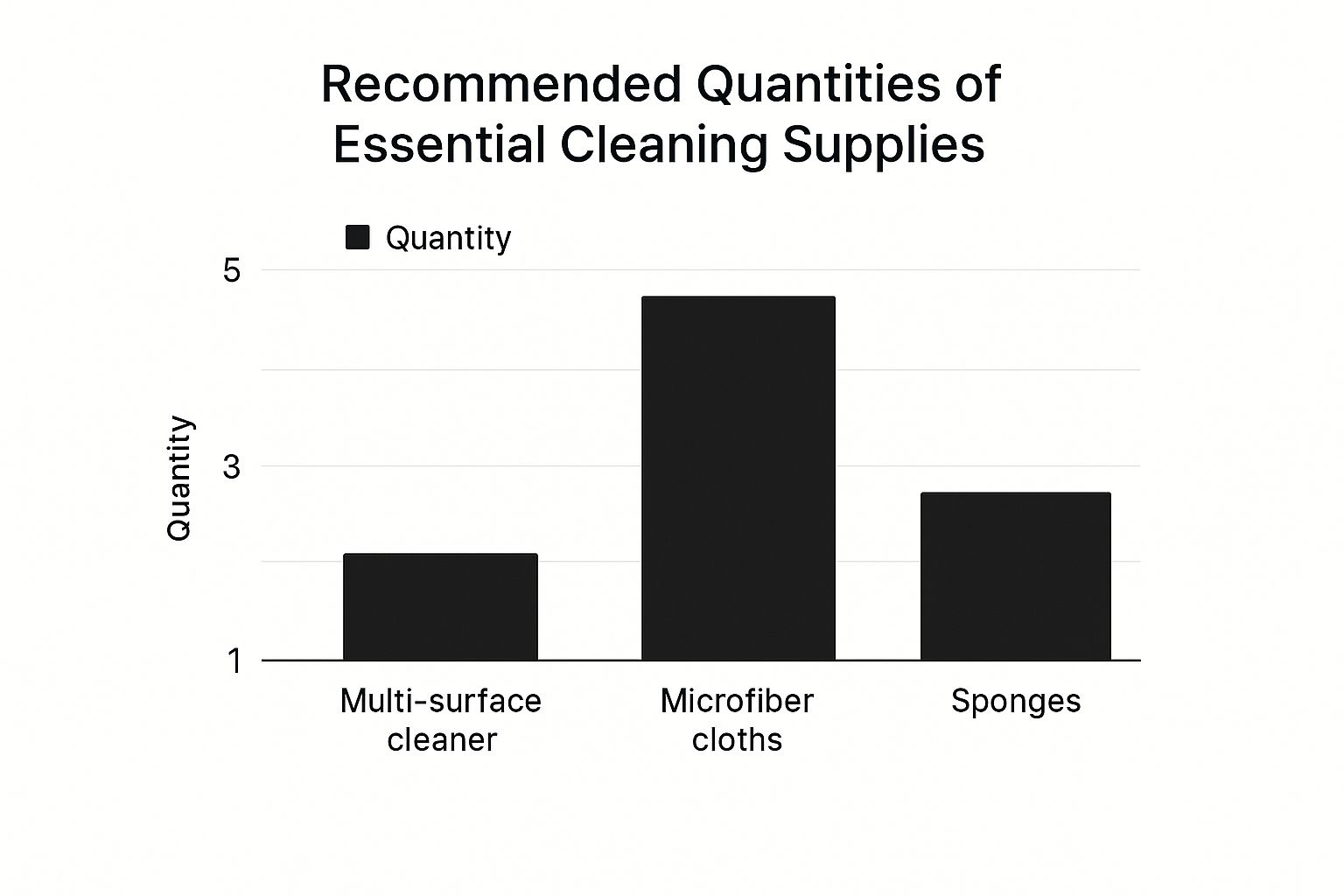
If you look closely at the image, you’ll notice a smart principle at play: you'll always need more reusable tools, like cloths, than the actual cleaning solutions themselves. It’s a great reminder to stock up on the things you’ll reach for over and over. This core list is the foundation we’ll build upon as we tackle the specific needs of each room in your house.
Choosing Your All-Purpose Cleaning Products
All-purpose cleaners are the true workhorses in your household cleaning supplies checklist, but it’s a mistake to think they’re all created equal. To keep your home genuinely healthy—not just looking clean—you really need to understand the difference between cleaning, sanitizing, and disinfecting. People throw these terms around all the time, but they each mean something very specific.
First off, cleaning is simply about removing the visible stuff: dirt, dust, crumbs, and grime. It’s always the first step. Then you have sanitizing, which is about lowering the number of bacteria on a surface to a safe level, according to public health codes. This is what you want for places that touch food.
Disinfecting, on the other hand, is the heavy hitter. This is the process that actually kills viruses and bacteria. You’ll want to disinfect high-touch areas like doorknobs, light switches, and bathroom faucets, especially when someone in the house is sick.
A truly effective routine uses all three, and in the right order. You have to clean a surface first to get rid of the dirt. If you just spray disinfectant on a grimy countertop, it can’t do its job properly and kill the germs hiding underneath.
Decoding Product Labels and Ingredients
When you're standing in the cleaning aisle, the active ingredients on the label tell the real story. For instance, products containing bleach (sodium hypochlorite) are fantastic disinfectants, but they’re harsh and can damage sensitive surfaces. Plus, you absolutely need good ventilation when using them.
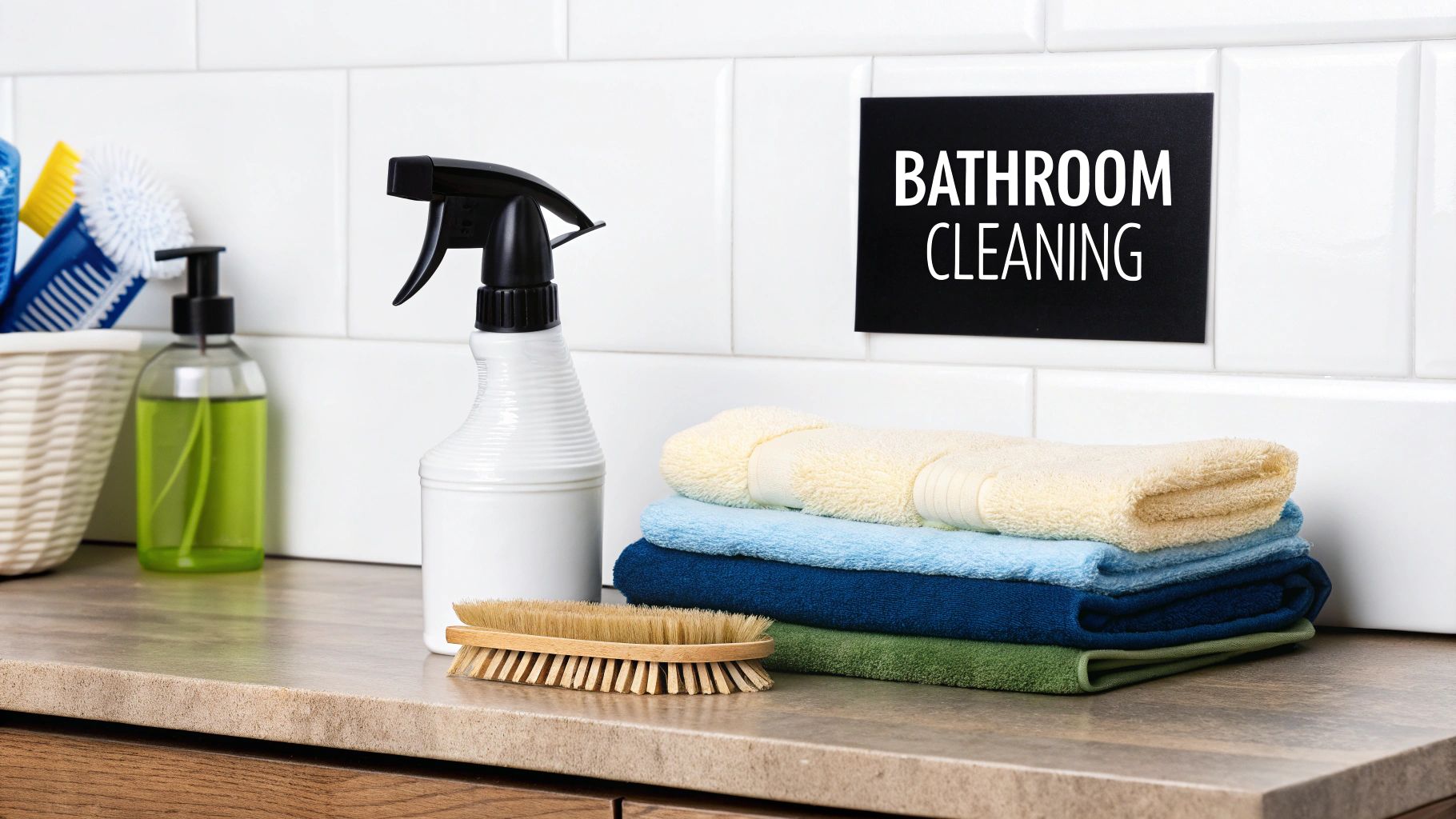
These days, you’ll see lots of products using gentler alternatives like citric acid or hydrogen peroxide. While they're often a great choice, if you need to disinfect, always check the label to make sure it’s an EPA-registered disinfectant.
- For daily wipe-downs: A basic all-purpose cleaner or even a simple mix of vinegar and water is perfect for most countertops (just not stone!), tables, and shelves.
- For sanitizing: Look for a product that is explicitly labeled as a sanitizer. This is what you’ll want for kitchen counters, high chairs, and cutting boards.
- For disinfecting: Make sure you grab an EPA-registered disinfectant. The most important part is following the instructions for “dwell time”—that’s how long the surface needs to stay wet for the product to actually kill everything it claims to.
The household cleaning market is enormous and shows no signs of slowing down, which tells you just how much people care about hygiene. The global market was valued at USD 235.94 billion and is expected to reach about USD 384.31 billion by 2034.
Picking the right cleaner also means knowing what not to use it on. For example, never use bleach on your stainless steel appliances or granite countertops. Similarly, acidic cleaners like vinegar can permanently etch natural stone like marble. When in doubt, always test a new product on a small, hidden spot first. It’s also a good idea to keep an eye on what products are trending now, as you might discover new formulas that are more effective or safer for your home.
Stocking Your Kitchen for a Hygienic Space
We all know the kitchen is the heart of the home. It’s where meals are made and memories are created. But let's be honest, it's also a ground zero for grease, sticky fingerprints, and food-borne bacteria. A single all-purpose spray just won't cut it in here; this room needs its own dedicated arsenal on your household cleaning supplies checklist. To really get things clean, you need products specifically designed to tackle everything from burnt-on casserole disasters to greasy stovetops, all while keeping things safe.
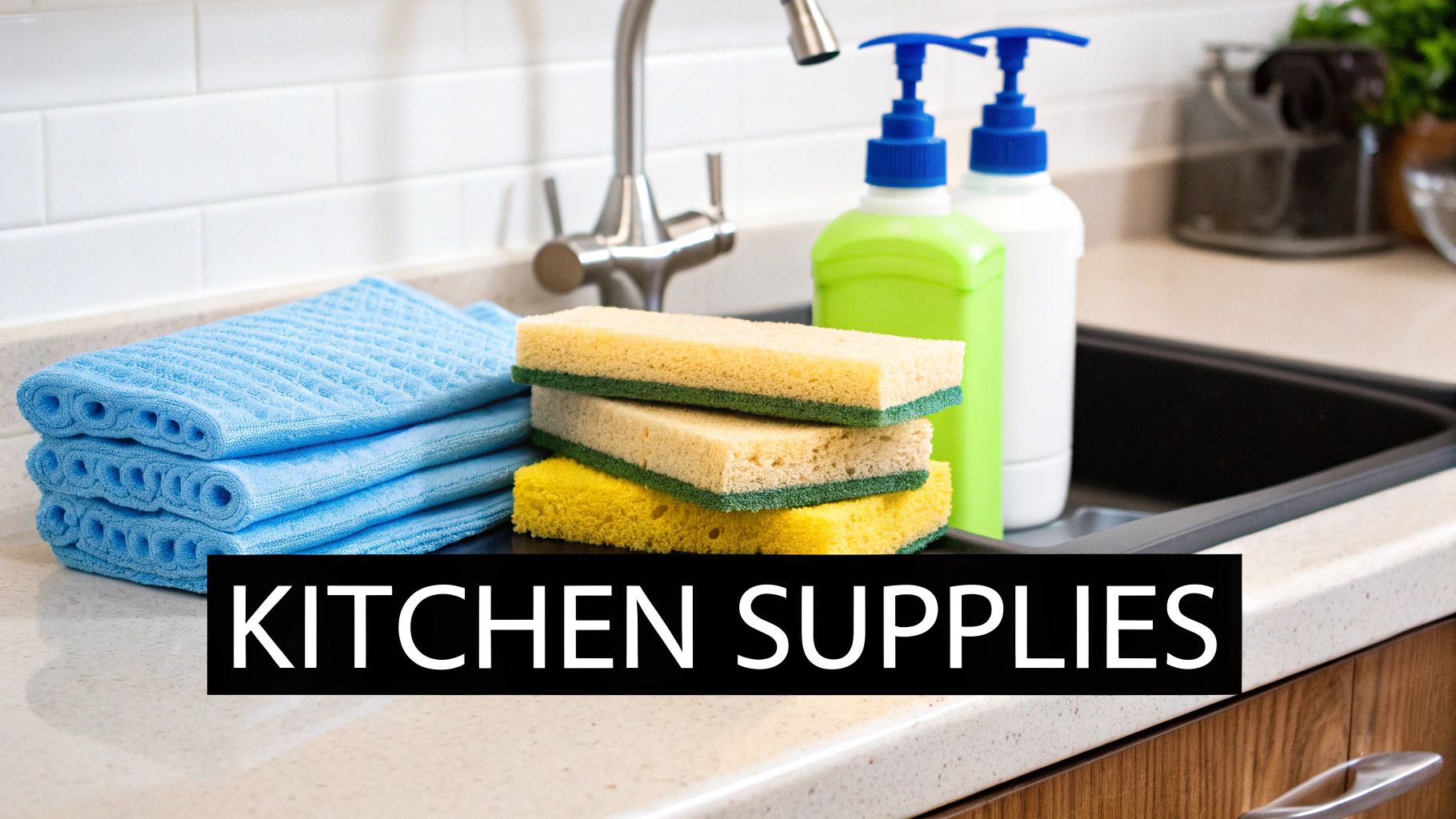
The trick is balancing serious cleaning power with food safety. You absolutely need a strong degreaser for that grimy film that builds up on the stove hood and backsplash. At the same time, a food-safe sanitizer is non-negotiable for countertops and cutting boards to stop cross-contamination in its tracks, especially between raw meats and fresh veggies.
Essential Kitchen Cleaning Supplies
To get your kitchen truly sparkling and ready for your next culinary adventure, your cleaning caddy should have a few specific workhorses. And remember, never underestimate the power of a good bottle of dish soap—it's a surprisingly versatile tool for cutting grease on more than just your plates.
- Dish Soap: The MVP for handwashing dishes, of course, but also fantastic for wiping down greasy cabinets, backsplashes, and even spot-cleaning floors.
- Heavy-Duty Degreaser: This is what you'll reach for to dissolve that tough, cooked-on gunk on stovetops, oven hoods, and the wall behind the stove.
- Food-Safe Surface Sanitizer: An absolute must-have for any surface that touches food. Think countertops, cutting boards, and high-chair trays.
- Oven Cleaner: A specialized, powerful formula designed for one job: breaking down the carbonized, burnt-on food and grease inside your oven.
- Stainless Steel Cleaner: If you have stainless appliances, this is your key to a streak-free finish that repels fingerprints and smudges.
A foundational rule for kitchen hygiene is preventing cross-contamination. I always recommend using separate, color-coded microfiber cloths for different jobs. For instance, use one color for food prep surfaces and a completely different one for wiping up spills from the floor.
A clean kitchen does more than just look good—it helps keep pests at bay. Wiping up crumbs is a great start, but it's also smart to know how to control fruit flies, which can show up seemingly out of nowhere. After all, a tidy, organized kitchen is the perfect backdrop for trying out new cooking recipe ideas.
Bathroom Cleaning Essentials for a Sparkling Finish
The bathroom presents a unique set of cleaning challenges. It’s a high-traffic, high-humidity space that needs specific products to deal with everything from stubborn soap scum and mildew to tough hard water stains. While a good all-purpose cleaner is useful, having a dedicated bathroom cleaning kit on your household cleaning supplies checklist is the real secret to making every surface shine safely and effectively.
Think about it: this one room has delicate finishes like chrome, porcelain, and tile grout, all of which can be damaged by the wrong kind of cleaner. The biggest hurdles you'll face are almost always soap scum buildup and the constant battle against mildew. Soap scum is that chalky, stubborn film that forms when soap minerals mix with hard water, and most general cleaners just can't cut it. Likewise, the steamy environment of a bathroom is pretty much a perfect incubator for mildew.
Must-Have Bathroom Cleaners and Tools
To tackle these common issues head-on and keep your bathroom looking pristine, you need to arm yourself with the right supplies. These products are specifically formulated to handle the unique types of grime found in a bathroom.
- Non-Abrasive Tub and Tile Cleaner: I always recommend looking for a spray or cream cleaner that clearly states it’s safe for acrylic, fiberglass, and tile. Abrasive powders might seem effective, but they can create tiny scratches on surfaces, which ironically makes them even harder to clean in the long run.
- Toilet Bowl Cleaner with Angled Neck: The angled neck isn't just a gimmick; it's crucial for getting cleaner right up under the rim where stains and germs love to hide. A good one will have a thick formula that clings to the bowl, giving it time to dissolve stains and disinfect.
- Streak-Free Glass Cleaner: This is your go-to for mirrors, glass shower doors, and chrome fixtures. A quality glass cleaner should evaporate quickly without leaving behind any annoying residue or streaks.
- Grout Brush or Stiff-Bristled Brush: Don’t try to make do with a sponge. A dedicated brush with stiff bristles is absolutely necessary for getting deep into grout lines and tight corners where mildew and dirt build up.
- Squeegee: If you take one piece of advice, let it be this: using a squeegee on shower walls and doors after every use is the single best way to prevent soap scum and mildew from ever taking hold. It takes 30 seconds and saves you hours of scrubbing later.
Here's a pro tip that will save your elbows: when you're cleaning, always apply your products and let them sit for a few minutes before you start scrubbing. This "dwell time" lets the cleaning agents do the heavy lifting for you by breaking down all that soap scum and grime. It means a lot less work for you.
Don't forget about proper ventilation, either. It's really important. Make sure you run the exhaust fan or crack a window open while you're cleaning and for a little while after. This helps get rid of fumes and dries everything out, which is another great way to stop mildew in its tracks. With these specific items in your cleaning caddy, you'll be more than ready to maintain a bathroom that's not just clean, but truly sparkling.
Finding the Right Supplies for Floors and Surfaces
Using the wrong cleaner on your floors or furniture is a surefire way to cause expensive, and sometimes permanent, damage. A huge part of building your household cleaning supplies checklist is matching the right product to each surface, whether you're dealing with delicate hardwood, durable tile, or soft carpeting. An all-purpose cleaner might seem like a good shortcut, but it can easily strip the finish from wood or leave a dull film on natural stone.
Think of it as protecting your investments. It all starts with knowing what each surface really needs. For instance, hardwood floors demand a pH-neutral cleaner made specifically to clean without harming the protective sealant. Many people reach for a simple vinegar and water mix, but its acidic nature can slowly eat away at the finish, leaving your beautiful wood exposed to water damage and stains.
Matching Cleaners to Floor Types
With so many different flooring materials out there, a one-size-fits-all approach just doesn't work. To keep every floor in your home looking its best, you’ll need to add a few specialized products to your shopping list.
- Hardwood Floor Cleaner: Always look for a pH-neutral, water-based cleaner. These formulas are engineered to gently lift dirt without leaving behind streaks or residue. Stay away from oil-based soaps; they tend to build up over time and can make your floors dangerously slick.
- Tile and Grout Cleaner: For standard ceramic and porcelain tile, a dedicated tile cleaner is perfect. The real battle, though, is usually with the grout. An alkaline-based grout cleaner is your best bet for breaking down the stubborn dirt and mildew that gets trapped in those porous lines. Don't forget a stiff grout brush—it's an essential partner for this job.
- Carpet Stain Remover: Life happens, so having a good carpet spot cleaner ready to go is non-negotiable. Enzyme-based cleaners are fantastic for tackling organic stains, like pet messes or spilled food, because they break down the proteins causing the stain and odor.
- Laminate Floor Cleaner: Just like hardwood, laminate needs a gentle approach. Use a cleaner formulated specifically for laminate floors, or just a tiny amount of mild soap in water. The key is to make sure your mop is only slightly damp to prevent any moisture from seeping between the planks.
Different flooring materials often have very particular care instructions. For example, cleaning rubber flooring involves its own unique process to ensure it stays in great shape for years to come.
Caring for Furniture and Upholstery
Your furniture needs the same specialized attention as your floors. Wood furniture, for instance, gets a new lease on life with a quality furniture polish that cleans, conditions, and protects the finish. While silicone-based polishes give a high shine, they can create a buildup that becomes a real headache to remove down the line. A carnauba wax-based polish is often a much better choice, offering a more natural-looking and protective layer.
When it comes to upholstery, always, always check the manufacturer’s cleaning code first—you'll usually find it on a tag. A 'W' means you can use water-based cleaners, 'S' means solvent-based only, 'W/S' means either will work, and 'X' means you can only vacuum. Ignoring these codes is a fast way to end up with permanent watermarks or faded colors.
The demand for these specialized products has created a massive global market. The cleaning products industry, which covers all these surface and floor cleaners, is a powerhouse. In fact, surface cleaners alone were projected to bring in nearly USD 61.13 billion in revenue in 2025. This number is expected to climb as more people look for targeted cleaning solutions. You can dive deeper into these market trends over at Coherent Market Insights.
Building Your Complete Laundry Room Arsenal
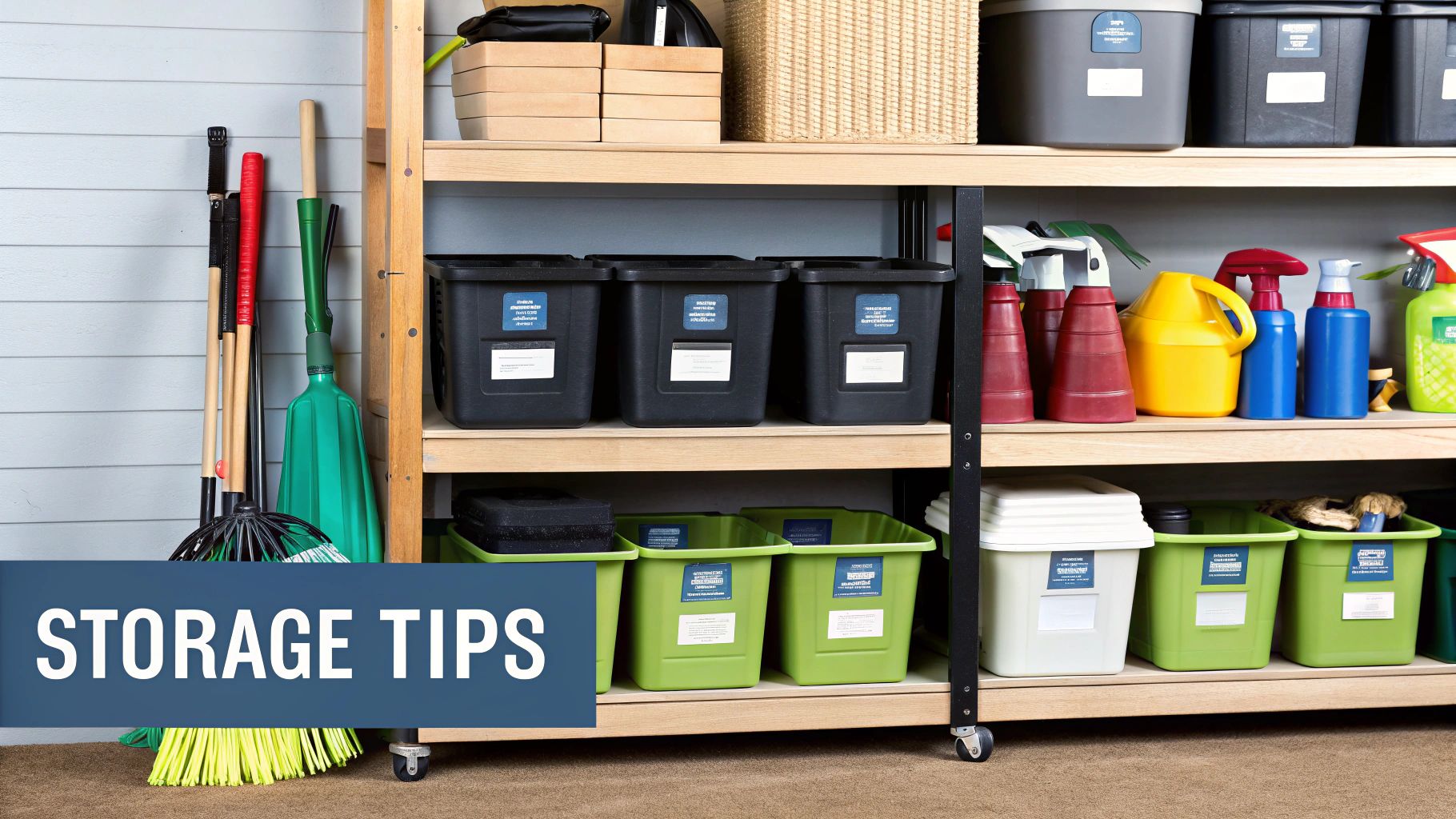
A truly effective laundry routine requires more than just a bottle of detergent. If you want to properly care for your fabrics, get them genuinely clean, and keep them looking their best, you need a well-stocked arsenal. Having the right items on your household cleaning supplies checklist helps you handle everything from frustrating stains to dull, dingy whites, ultimately making your clothes last longer.
Naturally, detergent is the star of the show. The choice between liquid, powder, and pods often boils down to your washing machine type and what you simply prefer to use, as each format has its own strengths.
- Liquid Detergents: These are fantastic for pre-treating stains directly and tend to dissolve very well, even in cold water washes.
- Powder Detergents: Often the most budget-friendly option, powders are powerhouses against tough, ground-in dirt like mud or clay.
- Laundry Pods: For ultimate convenience, you can't beat pods. Their pre-measured doses mean no guesswork and no messy spills.
Laundry detergent is a huge player in the cleaning industry, accounting for 37.6% of the entire global market. With the household cleaner market projected to hit USD 395.6 billion by 2034, we'll continue to see new and improved formulas. It's interesting to look at the cleaning market trends to see where these products are headed.
Specialized Fabric Care and Maintenance
Once you have your basic wash covered, a complete laundry toolkit should also include products for those specific challenges that always pop up. A good stain remover is an absolute must-have for pre-treating everything from grass smears to greasy splatters. And for fabrics that could use a little extra softness and a fresh scent, fabric softener or dryer sheets are key.
Don't forget to stock up on these targeted supplies, too:
- Laundry Sanitizer: Perfect for killing bacteria on items that need a deeper clean, like sweaty gym clothes, towels, or bed linens.
- Specialty Detergents: It's smart to keep a gentle formula on hand for delicates or a technical one for performance athletic wear to protect their unique fabric weaves.
- Washing Machine Cleaner: Cleaning your machine itself is a critical step people often miss. Running a cleaning cycle regularly prevents odor and residue buildup, which ensures your laundry actually comes out smelling fresh.
Putting Together Your Cleaning Toolkit
While cleaning solutions do the heavy lifting chemically, you won't get far without the right tools. Having the proper gear is what transforms a tough job into a quick, manageable task. It's a non-negotiable part of any complete household cleaning supplies checklist, because without these essentials, even the best products can't work their magic.
The absolute foundation of any cleaning arsenal is a solid collection of microfiber cloths. Their unique, fine-fiber weave is scientifically designed to trap dust and soak up spills far better than old cotton t-shirts, which tend to just smear dirt around. Keeping a good supply on hand is also key to preventing cross-contamination between, say, your kitchen and your bathroom.
Wiping and Scrubbing Essentials
Of course, some messes need more than a simple wipe. For built-up grime, you need tools with a little more elbow grease built in—without scratching up your surfaces. This is where having a variety of sponges and brushes really pays off.
- Microfiber Cloths (Set of 10-12): These are your go-to for dusting, wiping down counters, and polishing just about anything. A simple color-coding system (e.g., blue for glass, yellow for kitchen, red for bath) is a pro-level move to keep things hygienic.
- Scrub Brushes: A small, stiff-bristled brush is a lifesaver for getting into grout lines and other tight spots. A larger one is perfect for tackling bigger areas like tile floors or the shower basin.
- Non-Scratch Sponges: You’ll want these on hand for everything from daily dishwashing to scrubbing a messy stovetop without leaving behind any tell-tale marks.
Think of your tools as an investment that pays you back in saved time and effort. To get the most out of them, always rinse cloths and brushes well after each use. Let them dry completely to stop mildew and bacteria from growing.
Floor Care and Protective Gear
Taking care of your floors requires dedicated equipment, and taking care of yourself is just as important. A reliable vacuum is your number one defense against dirt, dust, and crumbs.
And don't forget about safety. A simple pair of rubber gloves can save your skin from harsh chemicals and hot water, making the whole cleaning process more comfortable. Once you have your tools, keeping them organized is the final piece of the puzzle. For some great tips, check out our guide on home organization ideas to build a system that keeps everything ready to go.
Answering Your Top Questions About Cleaning Supplies
Even with the best checklist in hand, a few questions always seem to come up as you build your cleaning arsenal. Let's tackle some of the most common ones I hear, because knowing how to use and store your supplies safely is just as important as having them in the first place.
Can I Just Make My Own Cleaning Supplies?
Absolutely. For many everyday messes, a simple DIY solution is fantastic. A 50/50 mix of white vinegar and water in a spray bottle works wonders on glass and many non-porous surfaces. Likewise, a paste of baking soda and a little water is a brilliant gentle abrasive for scrubbing sinks or tubs without causing scratches.
The key is knowing their limits. These homemade heroes are great for cleaning grime, but they are not disinfectants. They won't kill the nasty germs, bacteria, or viruses that lurk on high-touch surfaces. Think of them as excellent, budget-friendly additions to your kit, but don't rely on them to sanitize a kitchen counter after you've handled raw chicken. For that, you need an EPA-registered disinfectant.
Crucial Safety Note: Never, ever mix vinegar with bleach. This combination creates toxic chlorine gas, which is incredibly dangerous if inhaled.
What's the Right Way to Store Cleaning Supplies?
Safe storage is non-negotiable, especially with kids or pets around. The golden rule is to keep everything in a cool, dry place, away from sunlight, and completely out of reach. A high shelf in a laundry room or a locked cabinet is perfect.
Always leave products in their original containers. This isn't just for neatness; it ensures you have the instructions, ingredients, and safety warnings right where you need them. It’s also wise to avoid storing certain chemicals side-by-side, particularly ammonia and bleach. Even if they don't mix directly, their fumes can react in a small, enclosed space and create hazardous gases.
What's the Real Difference Between "Natural" and "Chemical-Free"?
Marketing buzzwords can make choosing products a real headache. Here’s a quick breakdown of what these terms actually mean:
- "Natural" usually implies the active ingredients come from plants or minerals. But remember, "natural" doesn't automatically equal "safe." Poison ivy is 100% natural, but you wouldn't want to clean with it.
- "Chemical-free" is a misnomer. Scientifically speaking, everything is made of chemicals, including water (H₂O). When companies use this phrase, they're trying to say the product is made without certain harsh synthetic chemicals like chlorine, ammonia, or phosphates.
Instead of getting tripped up by vague terms, look for reliable third-party certifications. The EPA's Safer Choice label is a great example. It signals that a product has been rigorously reviewed for its health and environmental safety, giving you much more confidence in your choice.
Ready to build the perfect cleaning kit? At FindTopTrends, we curate the best home essentials to keep your space sparkling. Explore our collection of top-rated home goods today!



